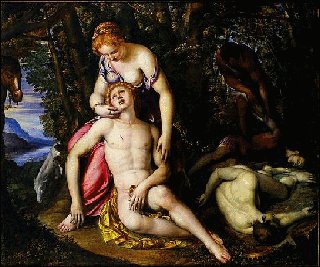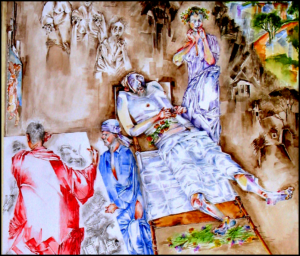Mad, Bad, and Dangerous Artists
THAT MOURNFUL PHRASE, uttered by Lady Caroline Lamb to describe her spasimante Lord George Byron is one, had it been around two hundred years earlier, could have been appropriated by anyone with the mixed fortunes to come within the orbit of Michelangelo Merisi, this early example of a tortured artistic genius be they fellow painter, rival, cardinal or the Pope himself. The artist who was known by the name of the commune where his relatively well-connected parents originated, Caravaggio in the province of Bergamo, was born in Milan 1571.
Caravaggio served an apprenticeship with a local painter Simone Peterzano who had worked with Titian in Venice. His style is, however, more Mannerist and it is this, rather than the Venetian interest in colour, that he passed on to Caravaggio. To a certain extent, Caravaggio’s stylistic relationship to Peterzano reflects that of Rembrandt van Rijn’s to his own master, Pieter Lastman, that is of a younger painter acquiring the tools he needed for his art from a good competent master to make an artistic jump of an order of magnitude that left his master far behind.

Caravaggio’s master, Simone Peterzano c.1540 – c.1596
Angelica e Medoro (private collection)
One tends to associate the beauties of great Old Masters paintings with an equally noble character of the man who painted it, but at no time over the centuries have admirers of his genius ever fallen into this trap. Caravaggio was what in Dublin would have been called a bowsie, an unpleasant, aggressive and unpredictable person.

Caravaggio as the devil;
detail in Giovanni Baglione’s
1602-1603 Sacred and Profane
Love. Galleria Nazionale
d’Arte Antica, Palazzo Barberini,
Rome
About the only artist whom we can safely call saintly is the Early Renaissance Florentine painter, Guido di Pietro (c.1395 – 1455). He is more commonly known as Fra Angelico the name he took on becoming a Brother in the Dominican religious order in Fiesole, Tuscany. Over the centuries many attempts were made to have him canonized but there was a certain resistance within the church to making any artist a saint, the life and example of Caravaggio being one reason. Eventually, through extensive pressure from, amongst others, the art historian Giovanni Urbani, he was beatified – a sort of half way house to canonisation – by Pope John Paul II in 1982. A better idea of the un-saintliness of painters in general can be gleaned from the nomi d’arte they often acquired in their lifetimes, amongst them, Sodoma, Giovanni Antonio Bazzi (1477-1549).
Shortly after the death of both his parents Caravaggio moved, in 1592, to Rome and, under the protection of the Borromeos a noble Milanese family related to the then pope, Pius IV helped him acquire lucrative commissions amongst the aristocracy and the clergy
The period July 1601 to Jan 1602 saw Caravaggio in Rome at the apex of his fame where he had an important influence on Peter Paul Rubens who was temporarily living there at the same time. The artist was competing with a now lesser known painter, Giovanni Baglione. Understandably irritated at the Milan painters superior talent Baglione had his revenge in 1603 when he had Caravaggio jailed for libel.
Although a bit of a bully and frequently given brief jail sentences, for what today we would call disturbing the peace, such as fights over prostitutes, his long-term reputation as an outsider was sealed when Baglione, who was, in addition, a writer published Caravaggio’s biography. In medieval Ireland it was always considered prudent to avoid offending poets; the damage they could cause ones reputation remained after you and the poet were long gone. A truth that, instinctively, Baglione was aware of. Indeed, the reputation of Caravaggio as a hooligan was not helped by a notorious incident where he used a prostitute, well known to the locals, as a model for the subject of ‘Death of the Virgin’ and subsequently refused by Rome’s church of Santa Maria della Scala. Added to this, Caravaggio fled Rome in 1606 having killed Ranuccio Tomassoni, a fellow playboy in a sword fight and remained badly wounded himself. These incidents were of great assistance to Baglione in his eagerness to publish as much unhelpful information as possible about the artist.
Still only 39 years old, in 1610 Caravaggio, still on the run as a fugitive from the Rome authorities for the death of Tomassoni, died unexpectedly at Porto Ercole, a coastal town in Tuscany and buried in the local church cemetery. The remains of 200 individuals including those of the artist, were exhumed in 1956 and reburied in the ossuary of the church crypt.

Caravaggio, 1604, Death of the Virgin painted for
Santa Maria della Scala, Rome, refused by church’s
Carmelite order: now in Louvre, Paris.
There is great importance attached nowadays to searching for the bones of long defunct painters. Most fashionable amongst trophy hunters are the bones of prominent artists, amongst them Rembrandt and Caravaggio.
In June 2010 Giorgio Gruppioni, a physical anthropologist with Italy’s National Committee for Historical, Cultural and Environmental Heritage sorted through the bones in the Porto Ercole crypt using DNA testing, carbon dating and other forensic tools before lighting on one set of bones matching those of a young male of Caravaggio’s age. Their DNA appeared to be similar to that of present-day descendants of the painter or persons bearing the same surname. The probable discovery of Caravaggio’s remains was received with great satisfaction in the world of art.

Two nervous picture dealers try to steal a precious Rembrandt canvas, under the eye of his grief-stricken family,
It is not much different to how the faithful searched in medieval times for the bones and relics of the saints. The emperor Constantine’s mother, Empress Helen was reputed in the fourth century to have found the remains of Christ’s cross on the crucifixion site of Golgotha. Harmen Baeukers, a medieval paleography researcher at the University of Leiden had less luck in 1989 locating the bones of Rembrandt. The artist’s straitened circumstances in the latter part of his life obliged his relatives to bury his remains in a temporary grave in the Amsterdam church of Westerkerk, in the Jordaan district. His son Titus was also buried there. These temporary graves, normally, were rented for a limited period of between 3, 5 or 20 years, as still occurs today in Italy, following which the grave was reused. His bones were placed in the communal ossuary from which, eventually, they would have been dispersed.
At least for the moment, Rembrandt is being left in peace, but poor Caravaggio’s bones are probably reflecting mournfully on Isaiah 57, ‘There is no rest for the wicked’.
If you need an appraisal of your old painting, contact Matthew Moss at Free Paintings Evaluation.